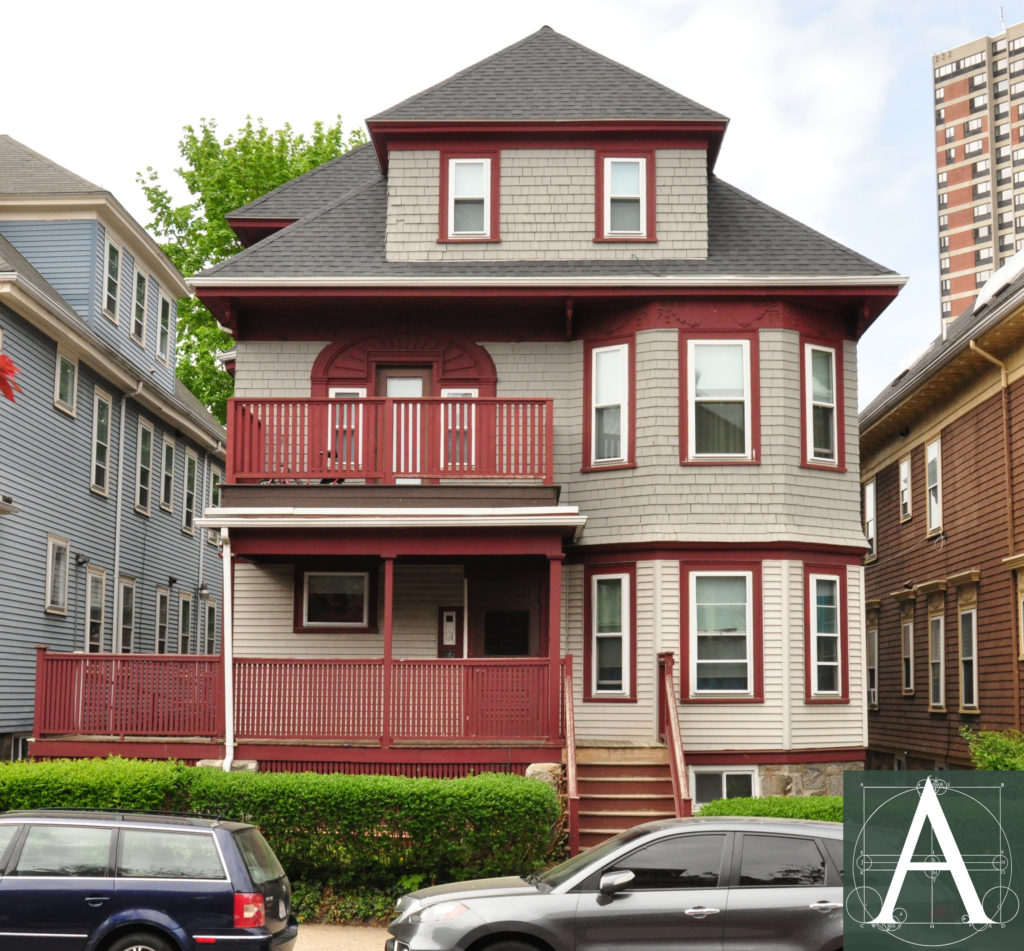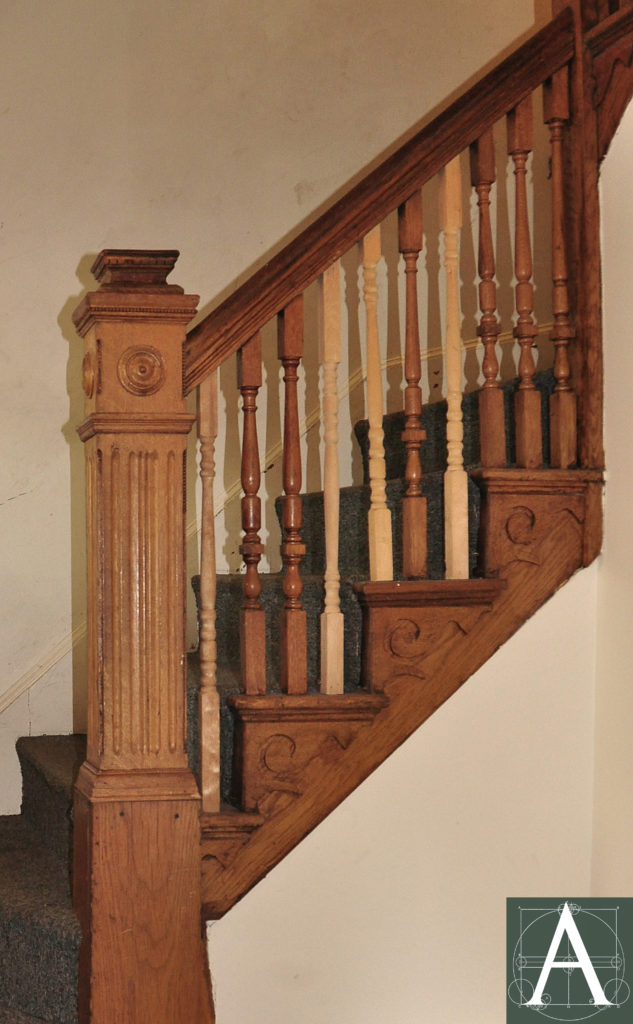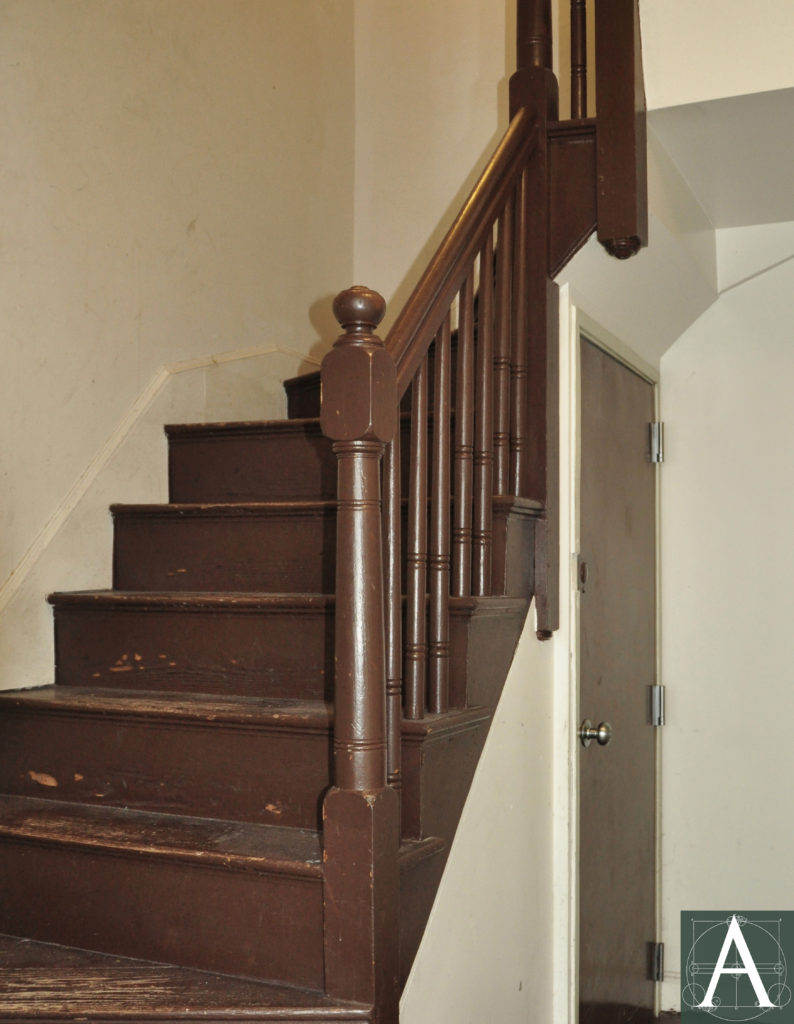Notable Elements
- Mortar applied over irregular stone faces, ruled and lined-out in red to give the appearance of random ashlar [see Foundation]
- Composition ornaments consisting of festoons [see Exterior]
History
The John F. Lowney Two-Family House is one of a large number of two- and three-family houses constructed on Fenwood Road and Francis Street at the foot of Boston’s Parker Hill in the last years of the nineteenth century and the first decade of the twentieth. The area in which the house stands was acquired by Jeremiah C. Spillane in 1897 for what was reported to be well above its assessed value of $250,000. Spillane quickly laid out streets and building lots. By 1899, the commercial/residential block at 733-747 Huntington Avenue was built, and 17 wood-frame residential buildings were scattered along Francis Street and Fenwood (then Kenwood) Road between Huntington Avenue and Vining (then Vila) Street. By 1906, virtually all the lots on Francis and Fenwood streets in this district had been developed, along with the Farragut School at the corner of Huntington Avenue and Fenwood Road.
Spillane was active in the real estate business from 1899 to 1913, and was directly responsible for the construction of twenty of the houses in this area, including 11, 15, 19, 32, 35, 36, 40, 43, 49, 54, & 56 Fenwood Road, and 12, 16, 20, 32, 34, 36, 38, 44, 50, & 52 Francis Street. The building permits usually list Spillane as the architect and builder of these residences, but no evidence of Spillane’s architectural training or experience has been uncovered. Other permits for buildings constructed by Spillane list individual architects; however, the similarity of the buildings’ plans and decoration suggests that architects were engaged primarily to produce drawings necessary for obtaining building permits and to individualize some of the building details, perhaps to the specifications of initial buyers. According to original building permits, the construction cost of these buildings was typically between $5,000 and $6,000.
At least eight professional architects are recorded as working in the Francis Street and Fenwood Road District. Most were local firms well-known for producing high-quality, one- and two- family houses and triple-deckers in Roxbury, Jamaica Plain and Brookline. The most prolific of the designers in the district, with five known buildings, was Samuel Rantin and Son of Roxbury, who designed 30 and 73 Fenwood Road, 40 Francis Street, 733 Huntington Ave (the Harmon Commercial Block) and 24 St. Albans Street. Fred W. Mahoney of Roxbury designed three buildings, at 32, 36, and 44 Francis Street. Architects P. J. Cantwells, Timothy Desmond, Cornelius Russell, J. Schwartz (the Avondale apartments at 777-779 Huntington Ave.), and R. H. Watson are also represented in the district. The Boston Landmarks Commission Inventory Form for 170 St. Alphonsus Street notes that “Samuel Rantin and Son… were responsible for designing during the 1890’s through the 1910’s, many triple-decker houses of unusually high quality—in the Parker Hill, Highland Park, and Hyde Square (Jamaica Plain) areas.” A collection of architectural drawings by Rantin and Son is contained in the archives of Historic New England.
Two-family houses in the area resembled the Lowney House in possessing large apartments, consisting of a six-room apartment on the first floor and a ten-room apartment occupying the upper two floors. Apartments in both two and three-family houses usually contained a parlor or double parlor, dining room, kitchen, pantry and between three and five bedrooms each. Initially purchased by upwardly mobile working-class and middle-class families with a high proportion of immigrants and first-generation Americans, apartments in the Lowney House and its neighboring buildings were typically occupied by an extended single family or a family with two or three lodgers.
At 32 Fenwood Road, the 1905 Boston directory records John F. Lowney, a clerk, as living at this address. In 1910, the building was occupied entirely by renters: William McClinchy (age 38), born in Massachusetts of Irish immigrants, was employed as a clerk for the City of Boston. He lived here with his wife Frances (age 36), also born in Massachusetts of Irish parents. The other apartment was occupied by Charlotte E. Mumford, a widow (age 60), who was born in Canada. She lived here with four of her six children, all born in Canada and without spouses: Arthur (age 32), a widower and a printer in a job shop, and three single daughters: Maud (age 34), a dressmaker, Gertrude (age 25), a student at nearby Simmons College, and Mary (age 20). Also part of Charlotte Mumford’s household were two grandchildren, Francis (age 5) and Phyllis (age 4), and boarder Lucie Hamblen (age 32), a single woman who worked in monotype copy at University Press.
Constructed between 1899 and 1905, the Lowney Two-Family House remained in use as two apartments probably until the 1940s when two-family houses along Fenwood Road were converted to three apartments by the separation of third-floor rooms into a separate unit. In 1941, an application to convert a nearby two-family house into three units asserted:
“This location is a two family house with six rooms downstairs and ten rooms upstairs. We are unable to rent ten rooms whereas a six room apartment and a four room apartment could be rented very easily at any time. The character of the neighborhood has changed considerably and a number of other houses on Fenwood Road built on the same type have been permitted to change to six room and four room apartments in place of the ten room apartment. These have rented immediately.”
The Building Commission quickly agreed, noting that this proposal was “the only logical development… to meet present day living conditions, and rehabilitates a building that would otherwise soon become dormant, and an eyesore to the neighborhood.” (City of Boston building permits for 31 Fenwood Road, 1941)
By the 1960s, Fenwood Road and adjacent streets had suffered deterioration and abandonment due to the migration of former residents to Boston’s suburbs. Much of the area was acquired by Harvard University. Most buildings in the area were subsequently transferred to the Roxbury Tenants of Harvard, a tenants’ cooperative that renovated the buildings by subdividing most apartments into smaller units. Original interior finishes were nearly entirely removed in the 1980s; however, notable exterior features remain in a rich variety of composition ornament and unusually varied masonry finishes at the foundations, such as the lined-out mortar joints of the Lowney Two-Family House, which were originally tinted red, as were those at 44 Fenwood Road while those of 52 Francis Street were lined out in white and those of 36 Fenwood Road were tooled with a raised bead in the natural color of the mortar, perhaps a natural cement.
Date
1900
Builder/Architect
Unknown
Building Type
Two-family house with one apartment at the first storey and a two-storey apartment at the second storey and attic
Foundation
As with the majority of buildings constructed in the Francis Street-Fenwood Road area, the foundation of the Lowney Two-Family House is constructed of Roxbury Puddingstone that was quarried on or near the building’s site. The rubble stonework was laid in random rubble, which was then lined out to resemble random ashlar. In some areas, mortar was extended over large stone faces to enhance the appearance of regularity. Joints appear to have been ruled out with upper and lower channels flanking a flat-finished mortar surface picked out in red. Lined-out mortar joints have long been used to provide the appearance of more regular masonry finishes. The majority of such finishes have weathered away and not been replaced in-kind; however, examples survive in sheltered locations on buildings throughout the Francis Street-Fenwood Road area. Sections of the foundation that were concealed by the front and rear porches are constructed in random rubble with untooled bedding mortar at their joints, as they were never intended to be exposed to view.
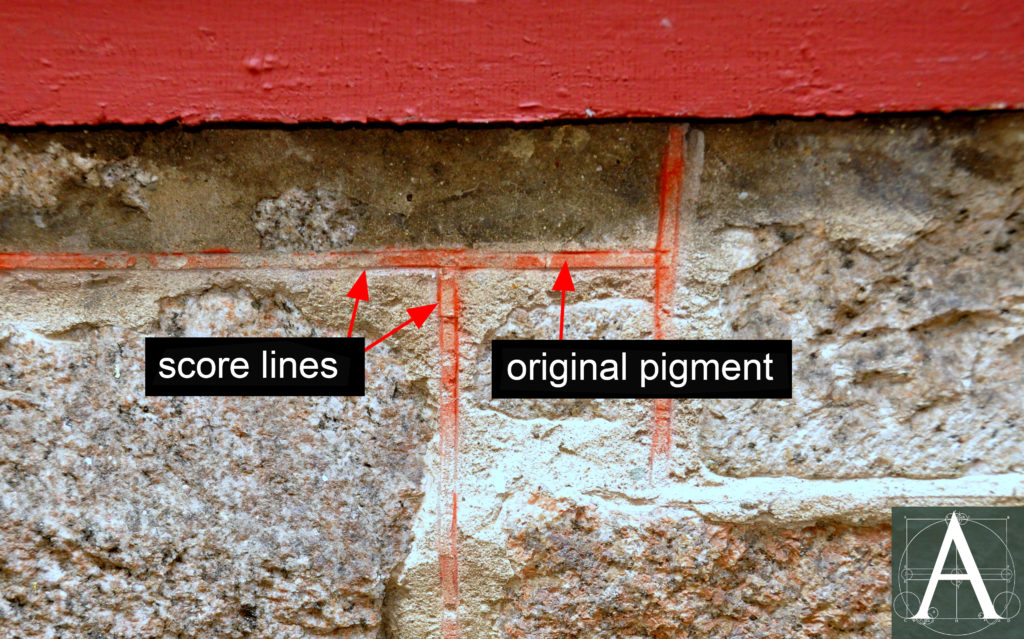
original mortar joints with scored edges and red pigment on sheltered location at side elevation of foundation
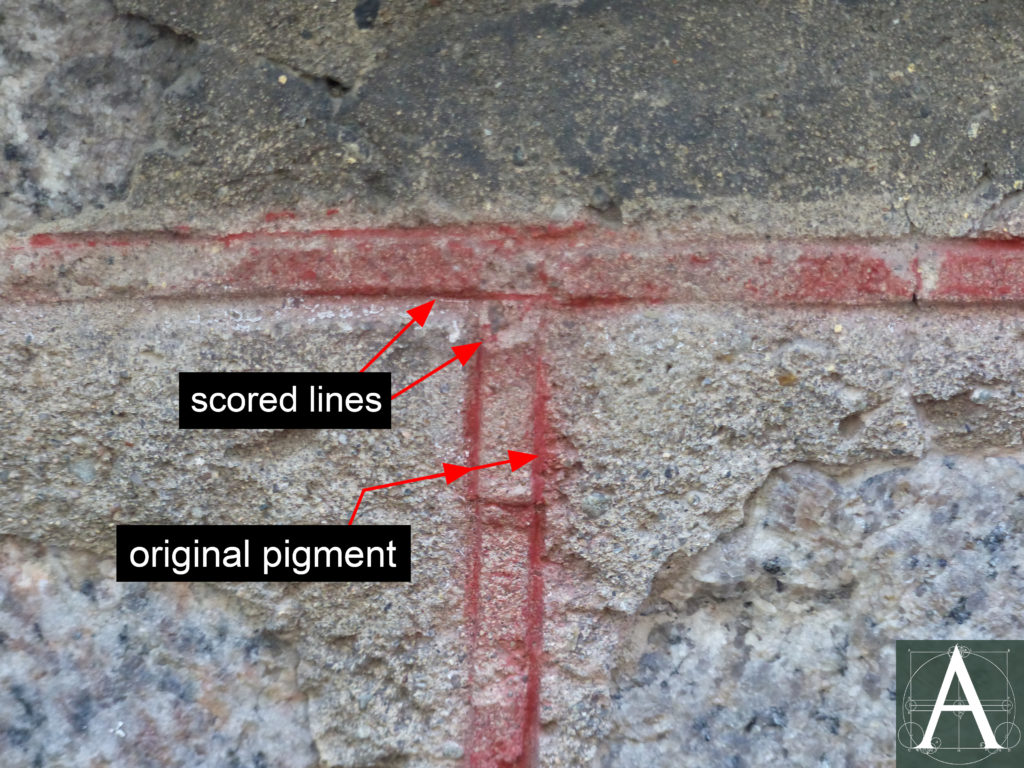
close-up of original mortar joints with scored edges and red pigment at sheltered location beneath the water table at side elevation of foundation
Frame
Building permits report that buildings in this area were constructed with mortise-and-tenon wood construction (braced frame). Building frames were not available for examination during the most recent building assessment (2014); however, braced frame construction remained in use for architect-designed buildings at least as late as 1887 (147 Brattle Street & 2 Riedesel Avenue, Cambridge, Massachusetts) and probably into the early twentieth century.
Interior
Original partitions, doors and finishes were nearly completely removed in the 1980s; however, the main staircase remains in position with a stock oak balustrade composed of square newels with pyramidal caps, turned balusters, a moulded wooden handrail and decorated tread ends. A rear staircase also remains with a simpler stock wood railing of turned balusters, newels stained dark brown and undecorated tread ends.
Exterior
At the first storey, all elevations are clad with aluminum siding that probably conceals clapboards, above which elevations are clad with wooden shingles, a pattern of siding characteristic of the period. Notable period elements include the façade’s second-storey tripartite arched window with a wooden fan contained within the arch and the main cornice decorated with composition ornament festoons, typical of those found on architecturally ambitious two- and three-families of the period. Ornaments such as these are found throughout the Francis Street-Fenwood Road area. It is not known whether these elements were selected entirely by the developer/architect or if potential buyers were offered options from which to choose, as many of the same details appear in different contexts on buildings throughout the area.
Contributor
Brian Pfeiffer, architectural historian; Wendy Frontiero, historical research
Sources
Unpublished conditions assessment conducted by Wendy Frontiero & Brian Pfeiffer, 2014.
“Francis Street – Fenwood Road District” unpublished nomination to the National Register of Historic Places. Wendy Frontiero, 2015. Filed at the Massachusetts Historical Commission.
Boston City Directories: 1875 – 1931.
Boston Daily Globe. “Real Estate,” Dec. 16, 1897; “Schoolhouse Lots,” Jan. 8, 1902; “Spillane on Trial,” Sept. 20, 1907; “Declares His Innocence,” Sept. 21, 1907.
Bromley, G.W. Atlas of the City of Boston. 1884, 1890, 1899, 1906, 1915, 1931.
City of Boston, Boston Landmarks Commission (Rosalind Pollan and Edward Gordon). 1984 Survey and Planning Grant; Part I – Parker hill/Mission Hill Project Completion Report, 1985.
City of Boston, Boston Landmarks Commission (Rosalind Pollan, Carol Kennedy, and Edward Gordon). 1983 Survey and Planning Grant; Part I – Fenway Project Completion Report, 1984.
City of Boston, Boston Landmarks Commission. “Exploring Boston Neighborhoods” brochures on Fenway/Kenmore (1996) and Mission Hill (1994).
City of Boston, Inspectional Services Department. Building Permits.
Commonwealth of Massachusetts, Secretary of the Commonwealth. Acts & Resolves Passed by the General Court of Massachusetts in the Year 1899. Boston: Wright & Potter Printing Co., 1899.

